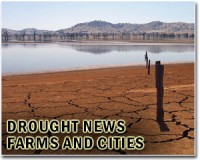| . |  |
. |
Toya, Mali (AFP) June 22, 2010 In single file, hundreds of residents of Toya wait patiently for meat distributed by the Red Cross who bought up thousands of starving animals to feed Mali's drought-stricken population. With containers in hand they await the meat from four cows slaughtered in the village in the north-west of the country last week which had lost too much weight from lack of grazing and water. Children scream with joy at the prospect of the meat coming their way. "The International Committee of the Red Cross (ICRC) operation is original and benefits the farmers as well as the population," says Mohamed Ali, local ICRC representative for the town in the Timbuktu region, some 900 kilometres (560 miles) north-east of the capital Bamako. "With the drought, the animals don't have anything to eat and drink. Then the ICRC buys the weakest animals, kills and distributes the meat to the needy. The farmer wins because of the money, the people too," says Ali. In northern Mali and northern Niger, the ICRC seeks to buy "38,000 head of cattle from 10,000 families of farmers and farmers affected by the cumulative effects of insecurity and drought," according to the organization. A health centre about 20 kilometres from Toya provides a good opportunity to feed the mothers of crying children. Here, there are no "real issues of malnutrition among children," says midwife Irma Coulibaly. "But we found that adults need to eat before being able to feed children properly." Along the roads in this region of Timbuktu, dead animals litter the ground. Dead from thirst. Ponds that usually contain water at this time of year are empty. Birds peck listlessly at the sand before flying off. "There is a sense of powerlessness within us. You see a cow which is thirsty, you can't do anything. It dies in front of you. And you are more concerned with saving the rest of your flock," says Atoume, a young farmer in northern Mali. In the regions of Gao and Kidal, "it is worse," said Mahamane Dicko, a municipal councillor for the town of Douenzta, between Mopti and Gao. "I have just come from these areas. In some parts more than 70 percent of livestock has been decimated by the drought," said Dicko. This year, the drought is being felt more keenly than usual. "Already in 2009, rainfall was low and not well-distributed, especially in northern Niger and Mali. But this year there are more cattle," according to a source in the Malian ministry of agriculture. Amadou Ag Mamoud, a farmer in the Timbuktu region, is struggling to save his stock. "This year, rainfall was very poor and there are more animals than there is grazing and water." In late June, the World Food Programme (WFP) warned that "erratic rains during the last two planting seasons had reduced harvests in north-eastern Mali." The body estimates that some 250,000 vulnerable people would receive "urgent assistance from the Government, WFP and its humanitarian partners."
Share This Article With Planet Earth
Related Links Climate Science News - Modeling, Mitigation Adaptation
 Drought adds to Vietnam's power woes
Drought adds to Vietnam's power woesHoa Binh, Vietnam (AFP) June 20, 2010 Thunderstorms brought slight relief to parts of northern Vietnam in recent days but not to the Hoa Binh hydropower plant, where water levels hover just above the "dead point" when electricity output is severely restricted. In fast-growing Vietnam, where energy demand outstrips supply, that means further blackouts in a country that draws more than one-third of its power from hydroelectricity. ... read more |
|
| The content herein, unless otherwise known to be public domain, are Copyright 1995-2010 - SpaceDaily. AFP and UPI Wire Stories are copyright Agence France-Presse and United Press International. ESA Portal Reports are copyright European Space Agency. All NASA sourced material is public domain. Additional copyrights may apply in whole or part to other bona fide parties. Advertising does not imply endorsement,agreement or approval of any opinions, statements or information provided by SpaceDaily on any Web page published or hosted by SpaceDaily. Privacy Statement |